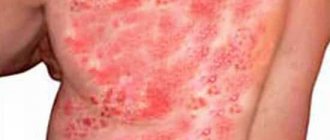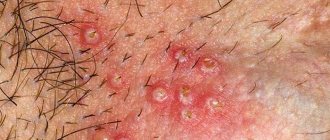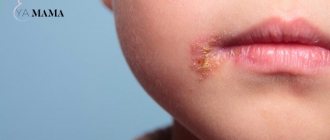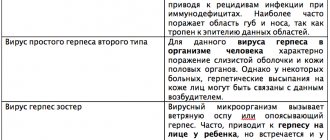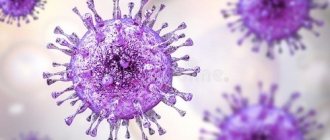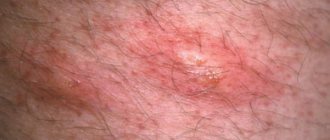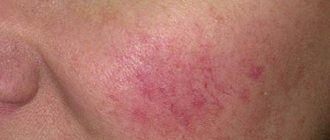Genital herpes is usually called manifestations of herpetic infection on the external or internal genital organs. Herpes simplex of the genitals is the second most common form of the disease, among other clinical variants of herpes simplex. The cause of its development is the herpes simplex virus. The most common type is herpes simplex virus type 2. Genital herpes can occur either as a result of primary infection with the virus or as a result of repeated infection, including through sexual contact. This form of herpes simplex is the most “unpleasant”, as it significantly reduces a person’s quality of life and significantly limits intimate relationships. Currently, the “herpesophobia” that has developed in society is associated specifically with genital herpes.
Causes
Genital herpes is a highly contagious disease, that is, very contagious, and the probability of transmitting the infection to a sexual partner is 100% during its exacerbation. No, it has long been believed that genital herpes is caused by the herpes simplex virus type 2, but it has been proven that herpetic manifestations on the genitals can also be caused by HSV-1, which is characterized by symptoms of the so-called “cold” (formation of blisters around the mouth or on the lips) .
However, being infected with herpes does not mean that after infection a person will immediately become ill. The occurrence of herpetic eruptions is caused by a decrease in immunity for various reasons, and even upon contact with a patient, the sexual partner will not develop characteristic symptoms immediately; the manifestation of the disease can occur much later if conditions are favorable for the virus (decreased body defenses).
Genital herpes: routes of transmission
Sexual - as the name of this infection makes clear, the main route of transmission is sexual. Moreover, it does not matter what the sexual contact was:
- genital
- anogenital
- or oral-genital.
Airborne - transmission of the virus by airborne droplets is also possible, in particular HSV-1.
Household - a household route of infection cannot be ruled out, especially through wet household items and in the presence of wounds and cracks in the anus and genital area. Self-infection is also possible: transfer of infection from the lips to the genitals if hygiene rules are not followed.
From mother to fetus - there is also a vertical route of transmission, that is, with clinical manifestations of genital herpes during pregnancy, the fetus is infected either transplacentally or during childbirth when the fetus passes through the infected birth canal of the mother.
Sexual intercourse with genital herpes
Many men and women are concerned about the possibility of sexual intercourse with genital herpes.
The following basic rules must be remembered:
- If you have symptoms of genital herpes and the disease is in the active phase, you must completely abstain from sexual intercourse;
- Barrier contraceptives do not provide protection against the causative agent of genital herpes;
- If the diagnosis is confirmed, you should warn your sexual partner ; he will also need to seek medical help for diagnosis.
Risk factors
A relationship has been identified between the number of cases of genital herpes and the following factors:
- socio-economic status and financial situation (the lower they are, the higher the chances of “catch” the infection);
- gender (women are more often infected with genital herpes, but not because of weaker immunity, but due to the presence of a large area of mucous membranes of the genital organs);
- age (a sharp increase in the incidence of genital herpes by the age of 30–40, which coincides with the age of sexual activity).
Based on the above, we can identify high-risk groups for the incidence of genital herpes:
- representatives of the fairer sex;
- antisocial layers of society (prostitutes, homeless people, drug addicts, alcoholics);
- homosexuals;
- representatives of the Negroid race (blacks suffer from genital herpes in 45% of cases, and Europeans only in 17%).
Risk factors for infection with genital herpes and the development of the disease include all immunosuppressive causes and promiscuity in sexual intercourse:
- promiscuous sexual intercourse;
- neglect of mechanical means of protection (condoms provide only 50% protection);
- stress;
- overwork, chronic fatigue;
- lack of vitamins;
- insufficient and malnutrition;
- unfavorable living conditions;
- significant physical activity;
- hypothermia;
- recent acute respiratory viral infections and a high susceptibility to respiratory diseases;
- use of an intrauterine device;
- abortions;
- climate change;
- taking medications that suppress the immune system (cytostatics, glucocorticoids);
- HIV infection;
- presence of cancer;
- chronic foci of infection (caries, sexually transmitted infections, chronic tonsillitis and others);
- excessive alcohol consumption;
- insolation (both sunbathing and visiting a solarium).
All factors that suppress immunity in genital herpes are also causes of exacerbation.
Prevention
Prevention of genital herpes is aimed at strengthening the immune system and preventing infection.
The main preventive methods are:
- proper nutrition;
- maintaining a healthy lifestyle, giving up bad habits;
- regular physical activity;
- good sleep;
- avoidance of stressful situations;
- rapid treatment of any disease;
- control of sexual partners;
- use of contraceptive methods.
If there are frequent manifestations of herpes, it is recommended to consult a doctor who will prescribe effective treatment. Women planning a pregnancy should definitely undergo screening to protect their health and the health of their unborn child.
Herpes in the intimate area is a very unpleasant disease that brings discomfort to a person’s life. When the immune system is functioning properly, the body is able to fight the virus on its own. However, if infection does occur, you should consult a doctor at the first manifestations to receive timely help.
Forms of the disease
There are two forms of genital herpes: primary and recurrent. Primary genital herpes is said to occur when clinical signs appear for the first time after infection, which can happen after a couple of weeks or in some cases months. Recurrent herpes is a periodic exacerbation of the disease with the slightest weakening of the immune system. Depending on the number of exacerbations of relapses of genital herpes throughout the year, 3 degrees of severity are distinguished:
- mild degree – the number of relapses is 3 or less per year;
- moderate – exacerbations occur 4–6 times a year;
- severe - relapses occur monthly.
In turn, recurrent genital herpes has several forms of progression:
- atypical microsymptomatic or subclinical (symptoms are present, but do not cause excessive concern to the patient: slight itching, cracks instead of vesicles);
- atypical macrosymptomatic form (symptoms are expressed, but not fully manifested: there is itching and pain, but there are no blisters or there are vesicles, but there is no discomfort);
- abortive form (observed in patients who have previously received antiviral therapy and vaccine prophylaxis);
- the asymptomatic form is the most dangerous, since there are no clinical signs, and the patient continues to be sexually active, spreading the infection through partners.
Frequency and depth of relapses.
You shouldn't feel any discomfort.
Let's run to the doctor! The virus remains in the body after the primary disease, hiding in the nervous tissue for decades in a latent form. Relapses occur in the event of a severe decrease in immunity, which can be caused by hypothermia, overheating, severe stress, etc.
That is, it can have relapses either after a few days or after several years, depending on the state of the body, or it may never appear after the primary disease if the patient’s health remains consistently good.
Important! To treat herpes, our readers successfully use Elena Makarenko’s method. Read more >>>
In case of relapse, skin rashes, blisters and sores can be observed in approximately the same areas as during the initial infection. Moreover, these manifestations pass much faster and are much less accompanied by unpleasant sensations. Skin rashes go away when they recur, usually within a week.
Quite rarely, with relapses of the disease, there is a general deterioration in condition, fever, enlarged lymph nodes in the groin area, and headache. There may be pain when emptying the bladder.
The herpes virus remains in a latent state in the infected person’s body throughout his life, and during periods of exposure to stress factors, it migrates from the nervous tissue, causing recurrent disease.
Signs of primary genital herpes
The symptoms of primary genital herpes occur 3–14 days after infection and persist for 21–35 days, with symptoms increasing during the first week.
- First, redness, swelling, and unbearable itching and burning appear in the area of the affected skin and mucous membranes.
- After some time, bubbles (vesicles) filled with cloudy contents form in this place. The formation of bubbles is combined with general symptoms of intoxication: fever, muscle and abdominal pain, joint pain, weakness, sleep disturbances and nausea.
- In addition, the inguinal lymph nodes become enlarged, the labia or penis swell, and painful urination occurs.
- After 5–7 days, the vesicles open and in their place small ulcers are formed that are not prone to fusion. The ulcers crust over, are not deep and do not bleed, and heal without scarring.
- The primary episode of the disease is characterized by bilateral (symmetrical, on both sides) rashes.
- As the process subsides and the ulcers heal (the epithelium peels off), the discomfort in the affected area disappears.
In the event of a secondary infection, the discharge from the ulcers becomes purulent, and the formations themselves are very painful.
Recurrent genital herpes
The diagnosis of recurrent genital herpes is established in the event of detection of clinical signs and antibodies in the blood to the reactivated (return of activity) type of herpesvirus. In almost 50% of cases, exacerbation of the disease occurs in the first six months from the initial episode. It is characteristic that the intensity and duration of the symptoms of recurrent herpes are less pronounced in contrast to the primary manifestation of genital herpes. The relapse lasts 4–10 days, and more often exacerbations occur when infected with HSV-2 type.
The prodromal period, characterized by itching, pain or burning in the affected area, lasts 12 to 36 hours. Neuralgic pain may appear, radiating to the lower back and legs. Then rashes appear on the reddened area of the skin/mucous membranes, which are represented by both individual and grouped vesicles. Subsequently, the bubbles open and form erosions with uneven edges. General symptoms of recurrent herpes are either absent or represented by minor headache and weakness. Inguinal lymph nodes enlarge only with massive herpetic rashes.
Recurrent genital herpes can also occur in a different scenario, that is, in the form of atypical forms (arrhythmic, monotonous or subsiding course). With an arrhythmic course, relapses alternate with remissions without a clear periodicity (from 2 weeks to 6 months). Moreover, the longer the remission lasts, the longer and more pronounced the exacerbations and vice versa.
The monotonous course is characterized by frequent episodes of the disease and periods of remission, during which the symptoms of herpes undergo virtually no changes. The monotonous course of the disease is persistent and difficult to treat. The most favorable type is genital herpes of the subsiding type. With each new exacerbation, the severity of manifestations decreases, and the duration of remissions increases.
Herpetic rashes are extremely painful, which makes it difficult for the patient to move, go to the toilet and disturbs sleep, this cannot but affect the mental state (the patient becomes irritable, he develops phobias: fear of new rashes, fear for the health of relatives, thoughts of suicide).
Herpetic infection of the genitourinary system in men
N
The uncontrolled widespread increase in the incidence of genital herpes (GG) puts the problem of herpesvirus infection (GI) on a par with the most pressing socially significant health problems. The incidence of HS in Western European countries exceeds 80 cases per 100 thousand population. Currently, according to B. Halioua et al. (1999), there are 86 million people in the world infected with herpes simplex virus type 2 (HSV-II), traditionally associated with HH, although it has been proven that HH can also be caused by HSV type 1.
Our analysis of official statistics data showed that the incidence of HS in Russia for 1993–1999. increased from 8.5 to 16.3 cases per 100 thousand population, and in Moscow - from 11.0 to 74.8. The bulk of patients in Russia turn to doctors on their own: 70-94% of registered patients. The share of active identification of patients with HH by first-level health care providers during all types of preventive examinations in Russia was 22.7-27.8%, in Moscow - 5.4-7.2%. At the same time, obstetricians and gynecologists identify 45.1–54.8%, dermatovenerologists – 39.8–43.8% of the total number of actively identified patients with HS, and urologists account for no more than 5–12%.
While close attention is paid to the study of herpes of the external genitalia and the adverse effects of GI on the reproductive function of women, information about HSV as an etiological factor in diseases of the genitourinary system (GUS) in men is very limited. It should be said that assessing the true role of HSV in the development of pathology of the MPS organs in men, taking into account the frequent mild or asymptomatic course of the infection, often turns out to be a very difficult task.
Herpes is called “many-faced” and “insidious”, meaning the variety of manifestations of the disease and accompanying symptoms due to the peculiarities of the pathogenesis of GI. The main links of pathogenesis
herpes infections are:
1. Infection of the sensory ganglia of the autonomic nervous system and lifelong persistence of HSV in them.
2. Damage to immunocompetent cells, which leads to secondary immunodeficiency, creating conditions for relapse of the disease.
3. HSV tropism for epithelial and nerve cells, causing polymorphism in the clinical manifestations of herpetic infection.
Infection of the genitals occurs through close physical contact with a patient or a virus carrier during genital, oro-genital, genitorectal and oral-anal contact. Only 10% of infected people develop clinical symptoms of primary HH.
The virus begins to multiply at the site of inoculation, where typical blistering rashes appear, and penetrates the bloodstream and lymphatic system. At the early stages of HI, viral particles also penetrate into the nerve endings of the skin or mucous membrane, move centripetally through the axoplasm, reach the peripheral, then segmental and regional sensory ganglia of the central nervous system, where they remain in a latent state in nerve cells for life.
Infection of sensory ganglia is one of the important stages in the pathogenesis of HI. With herpes, the genitals are the sensitive ganglia of the lumbosacral spine, which serve as a reservoir of the virus for its sexual transmission. The spread of HSV in a centrifugal direction during a relapse determines the anatomical fixation of lesions during relapses.
HSV can affect any nerve formations, which will clinically manifest as various neurological symptoms depending on the properties of the nerve formations involved in the infectious process. When sympathetic nodes and peripheral nerves are affected, patients experience symptoms of ganglioneuritis; combined damage to the ganglia and segmental roots of the spinal cord causes clinical manifestations of ganglioradiculoneuritis. Irritation of parasympathetic fibers causes subjective sensations in patients in the form of a burning sensation. The peculiarity of the pain syndrome with recurrent herpes (HR) is that it can periodically occur regardless of skin manifestations, which greatly complicates its interpretation. Neurological symptoms, complicating the course of the disease and worsening the prognosis, occur in every 3rd patient suffering from recurrent genital herpes (RGH).
The literature describes cases of acute urinary retention, the cause of which was sacral myeloradiculitis (Elsberg syndrome), meningitis and radiculomyelopathy, the cause of which was HSV.
In 25% of patients with RGG, increased trauma, dryness and the formation of small painful bleeding cracks on the mucous membranes of the external genitalia due to mechanical irritation appear.
Clinical manifestations of GG in men
Herpes of the external genitalia
In most cases, primary infection of the genitals is asymptomatic, with the subsequent formation of latent carriage of HSV or a recurrent form of genital herpes. In clinically significant cases, primary genital herpes usually manifests itself after 1–10 days of the incubation period and differs from subsequent relapses by a more severe and prolonged (up to 3 weeks) course (Fig. 1).
The likelihood of developing a recurrent form of HH depends on the serological type of HSV: when the genitals are infected with HSV type 1, a relapse within a year occurs in 25% of people who had a primary episode of HH; in HH caused by HSV type 2, relapses occur in 89%.
Clinically, herpes of the external genitalia can occur in typical, atypical and subclinical (asymptomatic) forms.
In men, rashes are usually located in the area of the outer and inner layers of the foreskin, coronary sulcus, and scaphoid fossa. Less commonly, the head and body of the penis and the skin of the scrotum are affected.
Typical form of RGG
characterized by the classic dynamics of lesions (erythema - vesicles - erosive-ulcerative elements - formation of crusts) and local subjective sensations in the form of itching, burning, pain. The lesions are usually limited, less common and localized in the same area of the skin or mucous membrane. Frequent exacerbations of RGG are often accompanied by a deterioration in the general condition of patients, symptoms of intoxication due to viremia appear (headache, chills, malaise, low-grade fever), and the inguinal lymph nodes may enlarge and become painful.
Atypical forms of RGG
, which significantly complicate the diagnosis, may be due to: 1) a change in the development cycle of herpetic elements in the lesion; 2) unusual localization of the lesion and anatomical features of the underlying tissues.
In atypical forms of RGG, one of the stages of development of the inflammatory process in the lesion (erythema, blistering) or one of the components of inflammation (edema, hemorrhage, necrosis) predominates. According to the intensity of clinical manifestations, atypical forms can occur rapidly with manifestation (bullous, ulcerative-necrotic) or subclinically (microcracks), see Fig. 2-4.
Subclinical form of RGG
is detected mainly during virological examination of sexual partners of patients with any sexually transmitted disease, or during examination of married couples with impaired fertility.
Herpetic infection of the pelvic organs
A feature of GG is its multifocality. The pathological process often involves the lower part of the urethra, the mucous membrane of the anus and rectum, which can occur secondary to the occurrence of herpes of the external genitalia, or can occur as an isolated lesion.
According to the characteristics of clinical manifestations, it is advisable to divide herpetic lesions of the pelvic organs in men into:
• herpes of the lower part of the urogenital tract, anal area and rectal ampulla;
• herpes of the upper genital tract (Table 1).
Herpes of the lower part of the urogenital tract, anal area and ampulla of the rectum
manifests itself in two clinical forms:
focal
, characterized by the appearance of vesicular-erosive elements typical of herpes simplex mucous membranes, and
diffuse
, in which the pathological process proceeds as a nonspecific inflammation.
Herpes urethra
The generally accepted classification of urethritis distinguishes between viral urethritis caused by HSV and human papillomavirus (HPV). HSV is more often the cause of prolonged torpid urethritis and recurrent cystitis, as well as exacerbation of chronic prostatitis. The frequency of herpetic urethritis (HU) ranges from 0.3 to 2.9% of all registered non-gonococcal urethritis (Ilyin I.I., 1977; Nahmias A. et al., 1976), which allowed researchers in the 70s to classify HU as rare forms of urethritis. Work in recent years has shown that GU is detected in 42.4–46.6% of cases in men suffering from RGG (Baluyants E.R., 1991; Semenova T.B., 2000).
Subjectively, GU is manifested by pain in the form of burning, sensations of heat, hyperesthesia along the urethra at rest and during urination, and pain at the beginning of urination. The incubation period for the development of HU remains unclear, but is probably several months, less often weeks or days. During a clinical examination, hyperemia and swelling of the urethral sponges are determined, and scanty mucous discharge from the external opening of the urethra periodically appears. The course of HU is subacute or sluggish with periodic remissions and relapses. In the urethral discharge, epithelial cells and mucus usually predominate, and leukocytosis periodically appears. With a mixed infection, urethral discharge becomes more abundant and opaque. With a two-glass sample, the urine in the first portion is transparent, but contains inflammatory products in the form of floating threads and flakes.
The diagnosis of GU is made based on the isolation of HSV from material taken from urethral discharge in cell culture or detection of the HSV antigen by PCR.
The organs of the MPS in men are in a close anatomical and physiological relationship, which does not allow a mechanistic approach to assessing the results of laboratory research. Thus, detection of HSV in urine or urethral discharge allows us to suspect the possibility of involvement of the prostate gland in the infectious process, even if HSV is not detected in prostate juice, but there is clinical evidence of torpid prostatitis.
For dry urethroscopy
on the mucous membrane of the urethra there is usually a soft infiltrate (less often transitional) with fragments of red mucosa, with pronounced large folds and disappearing small ones. Herpetic lesions are represented by small single or merging erosions with polycyclic edges against the background of local vasodilation (focal form of GI), or severe focal hyperemia of the mucous membrane (diffuse form of GI). More often, the anterior and middle third of the urethra are involved in the process. Contraindications to urethroscopy are exacerbation of urethritis and the presence of herpetic eruptions in the glans, scaphoid fossa and inner layer of the foreskin of the penis. Urethroscopy is recommended when external manifestations of herpes have subsided, complaints from the urethra persist, the patient has chronic recurrent urethritis of unknown etiology, and other urogenital infections have been previously excluded.
Bladder herpes
The leading symptoms of herpetic cystitis are the appearance of pain at the end of urination, dysuric phenomena; hematuria is its characteristic manifestation. Patients have a urinary disorder: the frequency, nature of the stream, and the amount of urine change. Herpetic cystitis in men is usually secondary and develops as a complication during exacerbation of chronic herpetic urethritis or prostatitis. During cystoscopy, catarrhal inflammation and isolated erosions are observed.
Herpes of the anal area and rectum
Herpetic lesions of the anal area and rectal ampulla occur in both heterosexual men and homosexuals. The anal area can be affected primarily or secondarily (if the infection spreads in a patient with GI of the external genitalia). The lesion is usually a recurrent crack, which is often a reason for diagnostic errors. Such patients with an erroneous diagnosis of “anal fissure” end up with surgeons.
When the sphincter and mucous membrane of the rectal ampulla are damaged (herpetic proctitis)
patients are bothered by itching, burning sensation and pain in the affected area, small erosions occur in the form of superficial cracks with a fixed localization, bleeding during defecation. The appearance of rashes may be accompanied by sharp bursting pain in the sigmoid region, flatulence and tenesmus, which are symptoms of irritation of the pelvic nerve plexus. Rectoscopy reveals catarrhal inflammation and sometimes erosion. A diagnosis of herpetic proctitis can only be made based on the results of a virological examination of the patient.
Herpes of the upper genital tract
manifested by symptoms of nonspecific inflammation.
Typical
The clinical picture of herpetic lesions of the organs of the upper genitourinary tract is manifested by symptoms of nonspecific inflammation. It is very difficult to establish the real incidence of damage to the internal genital organs in men, since in 40–60% of cases the disease occurs without subjective sensations.
In subclinical form
herpes of the internal genitalia, the patient has no complaints; Clinical examination does not reveal symptoms of inflammation. A dynamic laboratory study of smears of urethral discharge in the prostate secretion periodically reveals an increased number of leukocytes (up to 30–40 or more in the field of view), indicating the presence of an inflammatory process.
Asymptomatic form
Herpes of the internal genitalia (asymptomatic viral shedding) is characterized by the absence of any complaints and objective clinical symptoms of inflammation in patients. During a laboratory examination of the discharge of the urogenital tract, HSV is isolated, while in smears there are no signs of inflammation (leukocytosis).
Prostate herpes
In the modern etiopathogenetic classification of prostatitis, viral prostatitis is regarded as infectious canalicular complications of viral urethritis. According to the classification of Mears (1992) this type of prostatitis is classified as a doubtful or unproven type, according to Blumensaat (1961) - to a specific type, according to O.L. Tiktinsky and V.V. Mikhailechenko (1999) – to infectious.
In the development of viral prostatitis, the urethrogenic route of transmission is most often observed, and the descending (urogenic) route is rare - when viruses penetrate from infected urine during cystitis through the excretory ducts of the prostate gland (PG).
According to various authors, prostatitis is caused or maintained by HSV in 2.9–21.8% of cases (Weidner et al., 1981). Most often, chronic prostatitis with herpetic urethritis and RGG manifests itself in a catarrhal form, while the course of the disease is characterized by a frequent and persistently recurrent nature (O.B. Kapralov, 1988; Bennett et al., 1993).
In clinical practice, the diagnosis of chronic herpetic prostatitis is rarely made by urologists. The reason, apparently, is that virological diagnostic methods are not included in the standard examination of patients with chronic prostatitis. The doctor’s stereotype of thinking comes into play, and patients are traditionally screened for non-viral STDs. Meanwhile, with erased abacterial prostatitis, it can be assumed that the pathogenic agent is a virus.
In the clinical course of prostatitis, functional changes are noted - reproductive changes, pain (with irradiation to the external genitalia, perineum, lower back) and dysuric syndromes. In most cases, exacerbation of chronic prostatitis is preceded by the appearance of herpetic eruptions in the genital area. The appearance of vesicular-erosive elements may coincide with the appearance of complaints from the pancreas. Often in patients with RGG, prostatitis occurs subclinically: in these patients, the diagnosis of prostatitis is made based on the appearance of leukocytosis in the prostate secretion and a decrease in the number of lecithin grains.
It must be remembered that herpetic prostatitis can exist as an isolated form of GI. In this case, there are no symptoms of RGG and HSV is not detected in the urethral discharge. The etiological diagnosis is based on the detection of HSV in the secretion of the pancreas, while there is no pathogenic flora in the secretion and in the third portion of urine.
Ultrasound examination of the prostate gland in the area of the paraurethral zones of the prostate reveals hyperechoic fibrous foci measuring 3–9 mm. In patients with herpetic prostatitis, compared with abacterial prostatitis of unknown etiology, there is a greater severity of fibrous sections in the peripheral zones. Along with this, there is an expansion of the seminal vesicles, indicating a violation of their drainage into the posterior urethra, which suggests damage to the prostatic uterus.
The variety of clinical manifestations of herpes simplex, the presence of atypical, subclinical and asymptomatic forms of the disease, the involvement of many body systems in the infectious process often complicate the diagnosis of this disease.
Diagnosis of herpes
The diagnosis of recurrent genital herpes with typical clinical manifestations of the disease does not present any difficulties and can be made visually when examining the patient. Significant difficulties arise with atypical forms of HH or with herpetic lesions of the OMT. A carefully collected anamnesis is important in these cases. Complaints of itching, burning, scanty mucous discharge from the urethra, sanguineous discharge from the rectum, indications of pain, the recurrent nature of the OMT disease, as well as the resistance of the disease to previous antibiotic therapy. In addition, patients often note a tendency to colds, fear of drafts, periodic general weakness, malaise, low-grade fever, and depression. Patients with HH often experience pain, which patients do not always associate with exacerbations of herpes. Recurrent herpes, regardless of the location of manifestation of the pathological process, is characterized by a wave-like course, when painful states are replaced by periods of well-being, even without specific therapy.
The diagnosis of HSV infection is complicated by the fact that HSV is often in association with other microorganisms: chlamydia, strepto- and staphylococci, fungal flora, etc. A mixed infection of HSV with gonococcus, treponema pallidum, HIV cannot be ruled out, which indicates the need for careful patient examinations.
Existing methods for laboratory diagnosis of herpes simplex are fundamentally divided into two groups:
1) isolation and identification of HSV in cell culture or detection of the pathogen antigen from infected material through cytological, immunofluorescent studies, enzyme-linked immunosorbent assay (ELISA), PCR;
2) detection of virus-specific antibodies in blood serum.
The frequency of HSV isolation from different biological environments varies. When examining more than 200 patients with an established diagnosis of RH, suffering from chronic diseases of the urinary tract, HSV was isolated from urethral discharge in 22% of cases, prostate juice - 23%, sperm - 15%, urine - 26%. HSV may not be detected in everyone, but in 1–2 out of 3–4 biological materials obtained from the patient. Therefore, to reduce the likelihood of a false negative diagnosis, it is necessary to examine the maximum number of samples from one patient. A negative result of a single virological test cannot completely exclude the diagnosis of genital herpes. If an HSV infection is suspected, it is necessary to conduct a repeated virological examination of the discharge of the genitourinary system (once every 7 days, 2–4 times a month), and in some cases, use several examination methods.
The detection of IgM and/or a fourfold increase in the titers of specific immunoglobulins G (IgG) in paired blood sera obtained from the patient with an interval of 10–12 days is of diagnostic importance in primary HI. Recurrent herpes usually occurs against the background of high IgG levels, indicating constant antigenic stimulation of the patient's body. The appearance of IgM in a patient suffering from RGG indicates an exacerbation of the disease.
Treatment of genital herpes
General principles of treatment of herpes simplex
Modern medicine does not have treatment methods that can eliminate HSV from the body. Therefore, the goal of treatment is to suppress the reproduction of HSV during an exacerbation, the formation of an adequate immune response and its long-term preservation in order to block the reactivation of HSV in areas of persistence.
Currently, there are two main directions in the treatment of herpes simplex:
1. Antiviral therapy
, the main place in which is given to acyclovir (ACV) drugs, which are used to stop relapses of herpes, prevent and treat complications of HSV infection.
2. Complex treatment method
, which aims to increase inter-relapse periods, includes immunotherapy (specific and non-specific) in combination with antiviral treatment.
Correction of disorders of nonspecific and specific immunity is one of the main directions in the complex therapy of herpes simplex.
Synthetic interferon inducers (IFN) have a pronounced immunomodulatory effect in the treatment and prevention of complications of herpes simplex. Among them is the domestic drug Poludan
.
To date, convincing clinical data have been obtained on the high effectiveness of Poludan for the treatment of various clinical forms of recurrent herpes. Poludan has a general immunostimulating effect, which makes it possible to use it in secondary immunodeficiency conditions caused not only by herpesvirus infections. In these cases, poludanum is injected subcutaneously into the forearm: 200 mcg (1 bottle) is dissolved ex tempore in 1 ml of distilled water, administered daily, for a course of 10 injections.
One of the advantages of the IFN inducer tilorone
(Amiksin)
is the oral route of administration, which allows patients to independently carry out preventive courses of anti-relapse therapy recommended by their doctor. The mechanism of action of Amiksin includes: induction of interferons of types a, b, g, immunocorrection and direct antiviral effect. Amiksin has a mild immunomodulatory effect, stimulates bone marrow stem cells, enhances antibody formation, and reduces the degree of immunosuppression.
Amiksin is included in the complex treatment of RGG according to the following regimen: 250 mg once a day for 2 days, then 125 mg every other day for 3–4 weeks. According to the same scheme, Amiksin can be recommended to patients between courses of vaccine therapy to prolong the achieved effect.
Antiviral activity of the IFN inducer – Arbidol
due to its immunomodulatory and antioxidant properties. Arbidol can be included in the complex treatment of RH (0.2 g 2 times a day with meals for 10–14 days) and used between courses of vaccine therapy to prevent relapses of herpes (0.2 g 1 time a day with meals for 2–3 weeks).
To stimulate the T- and B-links of cellular immunity in patients with recurrent herpes, Taktivin, Timalin, Timogen, Myelopid and other immunomodulators can be used.
Specific immunotherapy consists of the use of domestic herpetic vaccine
(polyvalent, tissue, killed). The therapeutic effect of the vaccine is associated with the stimulation of specific reactions of antiviral immunity, restoration of the functional activity of immunocompetent cells and specific desensitization of the body.
Taking into account the peculiarities of the pathogenesis of herpes simplex, the most appropriate way to achieve a therapeutic effect is the combined use of drugs with different mechanisms of antiviral action, which prevents the emergence of resistant strains of HSV. The use of interferons and their inducers in combination with a herpetic vaccine and immunomodulators allows for a comprehensive solution to the treatment of herpes simplex.
Local treatment of GI organs of MPS in men
Achieving a therapeutic effect in the treatment of herpetic lesions of the MPS organs in men is impossible without local treatment
.
If there are rashes on the skin and mucous membranes during RHG, patients are prescribed local antiviral drugs for external use: Zovirax (cream), Acyclovir-acri (ointment), Gevisosh (ointment), Viru-merz (gel), Epigen (aerosol), etc. P.
Local immunostimulating therapy is important in the treatment of HS. For this purpose, you can use Poludan
. Poludan for RGG is used in the form of applications to the lesion, for which 200 mcg of the drug (1 bottle) is dissolved in 4 ml of water, moistened with a cotton swab and applied to the lesion for 5–7 minutes. The procedure is repeated 2-3 times a day for 2-4 days.
In the treatment of herpetic urethritis, Poludan is used as instillation into the urethra (400 mcg diluted in 10 ml of water). The procedure is repeated once a day, every day for 5–7 days. You can use cycloferon liniment (according to the same scheme).
For herpetic proctitis, a pronounced therapeutic effect is observed when patients are prescribed Poludan solution in the form of microenemas (400 mcg diluted in 10 ml of water, 10 microenemas per course of treatment).
Along with local medicinal treatment, patients with chronic herpetic diseases undergo OMT traditional local manipulations: bougienage of the urethra, massage of the prostate, followed by total instillation of Poludan solution or cycloferon liniment. To achieve a more pronounced anti-inflammatory, absorbable and analgesic effect in such patients, it is advisable to include low-frequency laser therapy in the course of treatment. In this case, it is advisable to combine the intracavitary introduction of a fiber light guide into the urethra or rectum into the area of projection of the pancreas with laser reflexology.
Complex treatment of men suffering from herpes MPS, including general antiviral and immunostimulating therapy in combination with local treatment, leads to regression of clinical signs of chronic urethritis and prostatitis (reduction or resolution of pain and dysuria syndromes), normalization of laboratory parameters, persistent positive dynamics of the course of RGG in 85 –90% of cases.
Conclusion
Among viral diseases, herpes infection occupies one of the leading places, which is determined by the widespread distribution of HSV, 90% of its infection of the human population, the lifelong persistence of the virus in the body, the polymorphism of the clinical manifestations of herpes, and its resistance to existing treatment methods.
Currently, the pathogenic effect of HSV on the development of chronic genitourinary diseases in women, the course of pregnancy and childbirth, and the health of the fetus and newborn is not in doubt.
The role of HSV in the development of pathological processes in the male body is clearly underestimated. At the same time, according to domestic and foreign researchers, in men suffering from chronic inflammatory diseases of the pelvic organs, it is possible to detect HSV in the discharge of the genitourinary system in 50–60% of cases. It has been proven that HSV is an agent that disrupts spermatogenesis and has the ability to infect sperm. This is of particular importance for men of reproductive age and opens up new aspects in the interpretation and solution of the problem of infertile marriages. Literature:
1. Barinsky I.F., Shubladze A.K., Kasparov A.A., Grebenyuk V.N. Herpes. Etiology, diagnosis, treatment // M. – 1986. – 272 pp.
2. Borisenko K.K. // Genital herpes. In the book. Unknown epidemic: genital herpes. Pharmagraphics. – 1997. – p. 75–83.
3. Bragina E.E. // Patterns of disturbances in human spermatogenesis in some genetic and infectious diseases. – Author's abstract. diss. ... doctor of biological sciences – M. – 2001. – 54 S.
4. Genital infection caused by the herpes simplex virus (review information).// J. STDs. – 1994. – є 3. – p. 5–8.
5. Semenova T.B. Simple herpes. Clinic, diagnosis, treatment, prevention. // Author's abstract. diss. ... MD – 2000. – M. – 48 S.
Tiloron –
Amiksin (trade name)
(LENS–Pharm)
Atypical and abortive forms
There are the following types of atypical forms of the disease:
- edematous – when there is pronounced swelling of the affected surface of the skin/mucous membranes;
- hemorrhagic - vesicles filled with blood;
- erosive-ulcerative - ulcers form very quickly at the site of herpetic eruptions;
- necrotic – formation of ulcers and necrotic areas at the site of vesicles;
- rupioid - long-lasting flaky brown crusts are formed that protrude above the skin;
- subclinical - small, shallow cracks form in the affected area of the mucous membrane or skin, which do not last long and are accompanied by discomfort (itching, pain); there are no characteristic vesicular rashes. There may also be a complete absence of a clinic.
Symptoms of an atypical form of genital herpes are recorded in 60–65% of patients.
The difference between the abortive form of genital herpes and others is the rapid resolution of the process (no more than 1 - 3 days), that is, the course of the relapse is very short - abortive. The following types of abortive course of the disease are distinguished:
- erythematous – there is only a reddened itchy lesion of the skin/mucous membranes;
- papular - a reddened and itchy area with slight elevation of the skin/mucous membrane, but no blisters;
- prurigo-neurotic – there are no vesicles, but there is pain along the nerve endings.
Diagnostics
The main method for diagnosing herpes in men is a thorough external examination. When rashes appear, there will almost certainly be no errors with this diagnostic method.
A dermatologist, andrologist, venereologist, or even a therapist can conduct an examination to diagnose genital herpes. During the examination, the doctor examines the penis, its head, and the scrotum for inflammation or blisters. In some cases, a special brush is used to collect mucus from the urethra. This procedure itself is painless, but when urinating for several hours after it, you may feel a pain in the urinary canal.
In cases where the rash extends to the anus, visual examination of the anus and taking a sample from the rectum may be necessary. Sometimes the doctor uses a proctoscope to examine the walls of the rectum for the presence of herpetic fissures and vesicles.
Ideally, it is necessary to diagnose the disease even before the appearance of visual symptoms, at the stage of the appearance of itching, nagging pain and high fever. For this examination it will not be enough, and they resort to more accurate methods of diagnosing herpes:
- enzyme-linked immunosorbent assay (ELISA), which relates to serological methods and allows one to determine the presence in the body of antibodies to the herpes simplex virus by the Ig titer of class M and G. The presence of the virus in the body is clearly indicated by a fourfold increase in the titer of specific IgG in paired sera over 10 days, or IgM detection;
- Polymerase chain reaction (PCR), which detects viral DNA in samples taken from mucus, blood or body fluids;
- A cultural method that allows the identification of a virus by reproducing it on a specially prepared culture medium.
Most of these tests require a blood test.
The primary symptoms of herpes can be similar to the symptoms of many other diseases, which often makes it difficult to fight it and leads to the loss of precious time, during which the disease could already begin to be treated.
So, herpes is often confused with:
- colds with a primary increase in temperature and deterioration of health;
- food poisoning due to indigestion;
- hemorrhoids and rectal fissures - with damage to the anus or rashes on the walls of the rectum;
- impetigo, caused by bacteria and manifested by herpetic-like rashes;
- allergic irritations.
Particularly difficult to diagnose are atypical forms of genital herpes, in which the sets of symptoms can be unpredictable and capable of misleading even experienced doctors.
Common manifestations of genital herpes
In both men and women, the disease can manifest itself as:
- herpetic cystitis – frequent urge to urinate, blood in the urine;
- herpetic urethritis - at the beginning of urination there is pain and severe pain, there is blood in the urine;
- herpes of the anus and rectum - the formation of cracks in the anus, which recur when the immune system is weakened, bloody discharge during bowel movements, pain and intense itching in the sphincter area (irritation of the hemorrhoids), increased gas formation.
Manifestations of genital herpes in men
Genital herpes in men begins acutely, the primary symptoms resemble a cold: the head “breaks”, the lower back ache, there is a rise in temperature, weakness and malaise. After some time, itching, tingling or burning in the groin, numbness in the pelvic area after sleeping or sitting for a long time occur.
Enlarged and painful inguinal lymph nodes can alert a man, but this symptom is not always observed. Only after discovering erythema and swelling on the mucous membrane of the penis, scrotum or perineum, the stronger sex rushes to the doctor. Literally after a few hours, less often days of the prodromal period, transparent bubbles swell in the area of redness and swelling, localized on the foreskin and head of the penis, on the scrotum or inner thighs, cover the pubis, and in the case of anal intercourse, on the buttocks and around the anus. After a week, the vesicles open, turning into ulcers covered with a yellow coating. Then the ulcers “acquire” crusts and peel off.
Recurrent herpes in men occurs with less frequency than in the weaker sex, since the male body undergoes hormonal changes (pregnancy, menstruation) less often. But any serious illness, as well as stress (men are more susceptible to psychological stress due to the stereotype of “not showing weakness”) causes a relapse of the disease. And although exacerbations occur less frequently, they are more severe.
The consequences of genital herpes in representatives of the stronger sex include: herpetic prostatitis, urethritis and, less commonly, herpetic proctitis.
Prevention of herpes
Preventing herpes in men helps minimize the likelihood of contracting this disease. A reliable way to avoid the occurrence of genital herpes in men is to abstain from promiscuity.
The use of contraceptives cannot be considered a preventive panacea, since the risk of infection, even with its use in the case of regular sexual intercourse with unfamiliar partners, still remains.
The reason lies in the routes of penetration of the virus, which sometimes manages to penetrate into the body without contact of the mucous membranes of the genital organs. According to statistics, a condom in combination with Mirastimin provides only 90% protection against the herpes virus.
It is also worth remembering that even a seemingly healthy partner can be a carrier of the herpes virus. And if there are visible manifestations of genital herpes, that is, rashes on the skin of the genital organs, contact must definitely be avoided.
Strengthening the immune system is considered a good measure of prevention, including relapses. You should regularly take a complex of vitamins, create a balanced diet menu, exercise, and lead an active lifestyle in general.
You should not neglect visits to the urologist’s office for preventive purposes, since genital herpes, as well as some other sexually transmitted diseases, can be asymptomatic.
It would also be a good idea to independently examine the skin of the genital organs for emerging rashes.
Manifestations of genital herpes in women
The symptoms of a primary episode of genital herpes in women generally do not differ from those in men. The disease, just like in the stronger sex, begins with a prodrome (weakness, fever, loss of appetite and nausea, arthralgia and myalgia, pain in the lumbar region and lower abdomen, numbness of the skin in the pelvic area).
The period of rash begins 2–3 days after the prodromal period and is characterized by the appearance of vesicles with cloudy liquid on the vulva (clitoral area, labia minora and majora, on the commissures), in the urethra, vagina and on the cervix. Vesicles may form in the anal area, on the inner thighs and perineum. In case of damage to the urethra, tingling and itching occur when urinating, and in severe cases, the herpetic infection spreads to the uterus and appendages.
Not always, but painful and enlarged lymph nodes in the groin are also noted. In most cases, genital herpes in the fair sex occurs in an atypical form (about 65%). In addition, women during the period of relapse of the disease note an increase in vaginal discharge, which becomes especially intense towards the end of the second phase of the menstrual cycle.
Typically, women have a much harder time psychologically with relapses of the disease, which leads to the development of depression, phobias (fear of sexual contact, fear of communication), suicidal thoughts, and neuroses.
Complications of the disease include:
- vulvitis;
- vulvodynia (itching and burning, there is weeping of the external genitalia, but there are no laboratory signs of inflammation);
- urethritis;
- adnexitis and salpingitis;
- chronic inflammation of the uterus;
- pelvic pain syndrome;
- emotional and mental disorders;
- problems in sexual life;
- decreased performance, psychasthenia (irritability and resentment, “close tears”).
Damage to the genital organs
When herpetic eruptions are localized in the area of the external genitalia in men, they quite often appear on the inner layer of the foreskin, in the head groove, and somewhat less frequently on the glans penis. The bubbles here usually exist for an extremely short time, quickly opening with the formation of painful erosions, which, due to constant maceration and friction, do not heal for a long time. It should be noted that regression of erosions in this area occurs, as a rule, without the formation of crusts. Erosions with their outlines exactly repeat the outlines of the vesicles in the places where they are formed. Due to the fact that herpetic vesicles are located in a group, they can form larger blisters with scalloped outlines. Among some features of the course of genital herpes in men, two main points should be noted that, directly or indirectly, affect the frequency and severity of clinical manifestations of the infection.
The first is a frivolous attitude towards the disease and unwillingness to be treated. Very often, men do not attach importance to the presence of herpes simplex, especially if relapses occur rarely. This attitude leads to an increase in the severity of the disease over time, as the immune system is gradually suppressed. Moreover, the risk of complications increases. We must not forget that the herpes simplex virus is a systemic infection and each exacerbation of it is dangerous for the body as a whole.
The second is alcohol abuse. This problem is relevant due to a decrease in immune defense. Alcohol has an extremely negative effect on the immune system and, therefore, causes more frequent relapses of the disease. As a result, complications of genital herpes simplex are more often observed in patients who abuse alcohol.
Genital herpes during pregnancy
If a woman had cases of genital herpes before pregnancy, then the risk of transmitting the infection to the fetus and newborn is minimal, but only if there are no relapses during gestation (see herpes during pregnancy). Genital herpes poses a huge danger during gestation during the initial episode of the disease or reactivation of the virus in the first 12 weeks and within a month before the expected due date. Exacerbation or primary infection of a herpetic infection leads to serious consequences in pregnant women:
- spontaneous termination of pregnancy;
- failed miscarriage (frozen pregnancy);
- premature birth;
- formation of malformations in the fetus;
- infection of a newborn when passing through the “infectious” birth canal.
In addition, genital herpes can cause recurrent miscarriage in the future, and even infertility.
Treatment
First phase of treatment
For genital herpes, the mainstay of treatment is antiviral therapy. The administration of antiviral drugs suppresses viral replication (reproduction), which quickly stops the clinical manifestations of the disease. Antiviral drugs are used both systemically (orally and parenterally) and locally (in the form of ointments, creams and suppositories). It is advisable to treat non-herpetic infections in a complex manner, by simultaneous administration of systemic and local drugs.
Today, such drugs as acyclovir, panavir, famciclovir and others have proven themselves. Etiotropic therapy (antiviral) involves phase 1 of the treatment of recurrent herpes. Antiviral drugs are prescribed according to a regimen of 2–5 times a day and last for 7–10 days or until the clinical phenomena completely disappear.
Simultaneously with the listed drugs, symptomatic therapy is prescribed, aimed at relieving pain and itching, as well as sedatives. In addition, in the first phase of treatment, ascorbic acid is indicated and a specific antiherpetic immunoglobulin is injected intramuscularly, which activates the patient’s immunity.
Second phase of treatment
It is carried out in the stage of subsiding of relapse (reduction of itching, formation of scabs on ulcers and their exfoliation). The administration of vitamins B1 and B6, autohemotherapy, and the use of antihistamines (tazepam, suprastin) and nonspecific (Eleutherococcus tincture, dibazol) and specific (lavomax) immunomodulators are indicated.
Third phase of treatment
It is carried out during the period of remission and is aimed at preventing relapses of the disease: the patient is vaccinated with a herpetic vaccine (duration of remission is at least 2 months), but vaccination is carried out necessarily after undergoing restorative and antiviral therapy.
After therapy
When treating genital herpes, stress, hypothermia and prolonged exposure to the sun should be avoided, the psycho-emotional state should be corrected, nutrition should be nutritious and rich in vitamins, and if necessary, bed rest should be prescribed.
Prevention of exacerbations
And, of course, all patients with recurrent genital herpes at the stage of exacerbation of the disease should avoid sexual contact, observe personal hygiene rules (wash the affected skin with warm water and soap) in order to avoid secondary infection. It is also prohibited to visit baths, saunas and swimming pools, and it is recommended to wear loose cotton underwear (prevents friction of the affected areas, allows the skin to “breathe” and reduces pain).
Author:
Sozinova Anna Vladimirovna obstetrician-gynecologist

